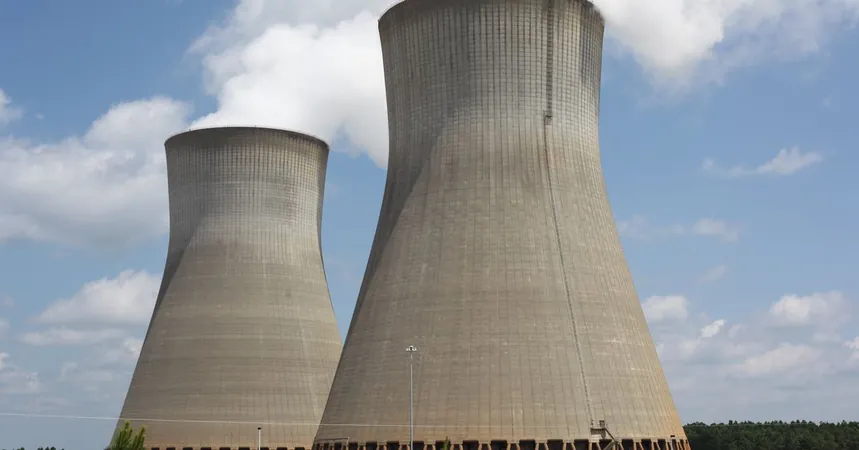
Can the U.S. Really Triple Its Nuclear Energy Capacity? Here's What You Need to Know!
2024-11-13
Author: Ling
Introduction
The United States has unveiled an ambitious plan aimed at dramatically increasing the share of electricity sourced from nuclear reactors. This roadmap was released by the Biden administration, yet its future hangs in the balance with Donald Trump poised to resume the presidency. Despite this political uncertainty, there is encouraging bipartisan support for nuclear energy, not to mention significant interest from major technology companies.
Current State of Nuclear Energy in the U.S.
Currently, nuclear power contributes nearly 20% to the U.S. electricity mix, comparable to the share from renewable sources like wind and solar. However, a whopping 60% of the nation's electricity still derives from fossil fuels. Significantly, nuclear facilities are crucial for producing nearly half of the United States' carbon-free power—making it a key player in the fight against climate change.
Environmental Concerns and Future Prospects
However, significant environmental concerns loom over aspects of nuclear energy, including uranium mining and the management of radioactive waste. Contrary to some worries, certain environmental groups and the Biden administration view nuclear energy as a viable option for generating electricity without greenhouse gas emissions. Moreover, nuclear power presents a consistent energy source that could stabilize the grid during periods of fluctuation in wind and solar energy generation.
Ambitious Targets
The White House set a bold target to achieve an additional 200 gigawatts of nuclear energy capacity by 2050—an ambitious increase from previous capacities. Initial goals include a rollout of 35 gigawatts by 2035, followed by a commitment to add 15 gigawatts per year by 2040.
Challenges Ahead
The task ahead is formidable. The American nuclear power landscape is characterized by an aging infrastructure, with the majority of reactors built in the 1970s and 80s. Currently, the average nuclear reactor in the U.S. is 42 years old, a statistic that raises concerns about safety and reliability. High-profile incidents such as those at Three Mile Island, Chernobyl, and Fukushima have contributed to public wariness regarding nuclear energy. Additionally, the industry has struggled to compete with cheaper and more flexible energy sources like natural gas.
Recent Developments
The recent completion of the Vogtle Unit 3 reactor in Georgia—the first new nuclear reactor commissioned in the U.S. in decades—demonstrates the challenges faced by the industry. The project was completed seven years late and went over budget by $17 billion, highlighting the complexities involved in constructing new nuclear plants. Fortunately, significant advancements are underway with the development of small modular reactors (SMRs), which are smaller and designed for reduced construction costs.
Government and Private Sector Initiatives
To achieve its nuclear goals, the Biden administration’s roadmap advocates for the construction of both new large reactors and SMRs while pushing for the extension of existing reactors' licenses and even the revival of retired reactors.
Industry Support from Tech Companies
Big tech companies are increasingly backing the nuclear sector. Microsoft recently entered into agreements to support the restart of a reactor at Three Mile Island, while Amazon Web Services has made substantial moves to acquire nuclear-powered infrastructure. Google has also announced plans to purchase electricity from future SMR projects.
Political Outlook
Looking ahead, Trump’s return could pose challenges to the Biden administration’s climate agenda, but his stance on nuclear energy could provide a ray of hope. His Agenda 47 includes promises to support nuclear production through regulatory modernization and investment in innovative technologies.
Conclusion
Yet, Trump's remarks during a recent interview may raise eyebrows as he expressed skepticism about a potential nuclear renaissance—referring to nuclear energy as possibly dangerous and diminishing the urgency of climate change. With conflicting signals, the future of nuclear energy in the U.S. remains uncertain yet crucial in navigating the landscape of renewable energy and climate resilience.
As tensions mount over energy solutions, one thing is clear: the road ahead for nuclear energy is filled with both potential rewards and significant risks. Will the U.S. be able to fulfill its ambitious nuclear goals? Time will tell, but the implications for the energy sector—and the environment—could be monumental!


 Brasil (PT)
Brasil (PT)
 Canada (EN)
Canada (EN)
 Chile (ES)
Chile (ES)
 España (ES)
España (ES)
 France (FR)
France (FR)
 Hong Kong (EN)
Hong Kong (EN)
 Italia (IT)
Italia (IT)
 日本 (JA)
日本 (JA)
 Magyarország (HU)
Magyarország (HU)
 Norge (NO)
Norge (NO)
 Polska (PL)
Polska (PL)
 Schweiz (DE)
Schweiz (DE)
 Singapore (EN)
Singapore (EN)
 Sverige (SV)
Sverige (SV)
 Suomi (FI)
Suomi (FI)
 Türkiye (TR)
Türkiye (TR)